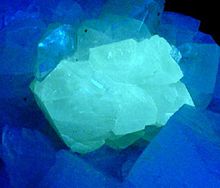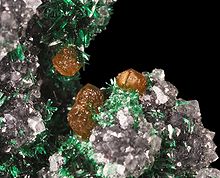Powellite
| Powellite | |
|---|---|
|
Powellite (white) on stilbite (beige) from Jalgaon , Maharashtra, India (size: 6.7 × 4.3 × 4.2 cm) |
|
| General and classification | |
| chemical formula | Ca [MoO 4 ] |
|
Mineral class (and possibly department) |
Sulfates (and relatives, see classification ) |
|
System no. to Strunz and to Dana |
7.GA.05 ( 8th edition : VI / G.01) 48.01.02.02 |
| Crystallographic Data | |
| Crystal system | tetragonal |
| Crystal class ; symbol | tetragonal-dipyramidal; 4 / m |
| Room group (no.) | I 4 1 / a (No. 88) |
| Lattice parameters | a = 5.22 Å ; c = 11.43 Å |
| Formula units | Z = 4 |
| Frequent crystal faces | {111}, {011}, {112} |
| Physical Properties | |
| Mohs hardness | 3.5 to 4 |
| Density (g / cm 3 ) | measured: 4.26; calculated: 4.255 |
| Cleavage | indistinct after {112}, {011} and {001} |
| Break ; Tenacity | uneven |
| colour | colorless, white, gray, light yellow, greenish yellow, brownish yellow, brown, blue to almost black |
| Line color | gray-white |
| transparency | transparent to translucent |
| shine | Resin luster to weak diamond luster, pearlescent luster |
| Crystal optics | |
| Refractive indices |
n ω = 1.974 n ε = 1.984 |
| Birefringence | δ = 0.010 |
| Optical character | uniaxial positive |
| Pleochroism | visible in brightly colored varieties: O = blue; E = green |
| Other properties | |
| Special features | Cream-white or yellow to golden yellow fluorescence under short-wave UV light |
Powellite is a rather rarely occurring mineral from the mineral class of " sulfates (including selenates , tellurates , chromates , molybdates and tungstates )". It crystallizes in the tetragonal crystal system with the composition Ca [MoO 4 ], so chemically speaking it is calcium molybdate . Powellite can thus be understood formally as a calcium salt of molybdic acid. Since it forms a mixed series with the related calcium tungstate scheelite , WO 3 contents of up to over 10% are possible in natural powellite .
Powellite usually develops thin tabular to dipyramidal crystals with a resinous luster to a faint diamond luster on the surfaces, but can also be found in the form of coarse masses, crusts and approaches. Also known are pseudomorphs after molybdenite . In its pure form, powellite is colorless and transparent. However, due to multiple refraction due to lattice construction defects or polycrystalline training, it can also appear white and, due to foreign admixtures, it can take on a gray, light yellow, greenish yellow, brownish yellow or blue to almost black color, with the transparency decreasing accordingly.
Etymology and history
Powellite was first discovered in the “Peacock” copper mine near Cuprum ( Adams County ) in the US state of Idaho and described in 1891 by William Harlow Melville , who named the mineral after the US researcher John Wesley Powell .
classification
In the meanwhile outdated, but still in use 8th edition of the mineral classification according to Strunz , the powellite belonged to the mineral class of "sulfates, chromates, molybdates, wolframates" and to the department of " molybdates and wolframates ", where it was named after the "Scheelite group" “With the system no. VI / G.01 and the other members paraniite- (Y) , scheelite , stolzite and wulfenite .
The 9th edition of Strunz's mineral systematics , which has been in effect since 2001 and is used by the International Mineralogical Association (IMA), assigns the powellite to the extended class of "sulfates (selenates, tellurates, chromates, molybdates and wolframates)", but also to the Department of "Molybdates and Wolframates". However, this is now further subdivided according to the possible presence of additional anions and / or crystal water , so that the mineral can be found according to its composition in the sub-section "Without additional anions or H 2 O", where it can be found together with fergusonite (Ce ) Fergusonite (Nd) , fergusonite (Y) , formanite (Y) , scheelite, stolzite and wulfenite form unnamed group 7.GA.05 .
The systematics of minerals according to Dana , which is mainly used in the English-speaking world , assigns powellite to the class of " phosphates , arsenates and vanadates " and there in the department of "molybdates and wolframates". Here he is only together with Scheelit in the "Scheelit series" with the system no. 48.01.02 to be found in the sub-section of " Anhydrous molybdates and tungstates with A XO4 ".
Crystal structure
Powellite crystallizes tetragonally in the space group I 4 1 / a (space group no. 88) with the lattice parameters a = 5.22 Å and c = 11.43 Å as well as 4 formula units per unit cell .
properties

( total size of the step : 12.0 × 9.6 × 6.5 cm)
Under short-wave UV light , some Powellites show a creamy white or yellow to golden yellow fluorescence .
Education and Locations

Powellite forms either in contact with metasomatic deposits or secondarily as a conversion product of molybdenite in the oxidation zone of molybdenum-containing hydrothermal deposits . Besides molybdenite occur as accompanying minerals , you still Apophyllit , Ferrimolybdit , Laumontit and Stilbit on.
As a rather rare mineral formation, powellite can sometimes be abundant at various sites, but overall it is not very common. Around 460 sites are known to date. In addition to its type locality "Peacock", Powellit appeared in many other places in the USA from Alaska to Wyoming .
In Germany, the mineral has so far been found in some places in the Black Forest in Baden-Württemberg, on the Hartkoppe near Sailauf and near Stützersdorf / Tittling in Bavaria, on the Bangertshöhe near Hochstädten (Bensheim) and the Kohlplatte near Sonderbach in Hesse, on the Ettringer Bellerberg in the Eifel (Rhineland-Palatinate) and near Königshain in Saxony.
In Austria Powellit entered so far only in the scheelite - deposit in Felbental ( Hohe Tauern on) in Salzburg.
In Switzerland, the mineral could be found in some places in the cantons of Graubünden , Ticino and Valais .
Other locations are in Australia, Brazil, Bulgaria, Canada, Chile, China, Finland, France, Greece, India, Italy, Japan, Kazakhstan, Morocco, Mexico, Mongolia, Namibia, Nicaragua, Norway, Russia, Sweden, Zimbabwe , Somalia, Spain, South Africa, the Czech Republic, Turkey and the United Kingdom.
See also
literature
- WH Melville: Powellite - Calcium molybdate: A new mineral species , in: The American Journal of Science , Volume 141 (1891), pp. 138–141 ( PDF 174.4 kB )
- VB Aleksandrov, LV Gorbatyii, VV Ilyukhin: Crystal structure of powellite CaMoO4 , in: Soviet Physics - Crystallography , Volume 13 (1968), pp. 414-415 ( PDF 109.4 kB )
- Helmut Schrätze, Karl-Ludwig Weiner: Mineralogy. A textbook on a systematic basis . de Gruyter, Berlin; New York 1981, ISBN 3-11-006823-0 , pp. 600 .
Web links
Individual evidence
- ↑ a b c d e Hugo Strunz , Ernest H. Nickel: Strunz Mineralogical Tables . 9th edition. E. Schweizerbart'sche Verlagbuchhandlung (Nägele and Obermiller), Stuttgart 2001, ISBN 3-510-65188-X , p. 419 .
- ↑ Webmineral - Powellite
- ↑ a b c d Powellite , in: John W. Anthony, Richard A. Bideaux, Kenneth W. Bladh, Monte C. Nichols (Eds.): Handbook of Mineralogy, Mineralogical Society of America , 2001 ( PDF 63.2 kB )
- ↑ a b c Mindat - Powellite
- ^ A b Helmut Schrätze, Karl-Ludwig Weiner: Mineralogie. A textbook on a systematic basis . de Gruyter, Berlin; New York 1981, ISBN 3-11-006823-0 , pp. 600 .
- ^ Mindat - localities for powellite
